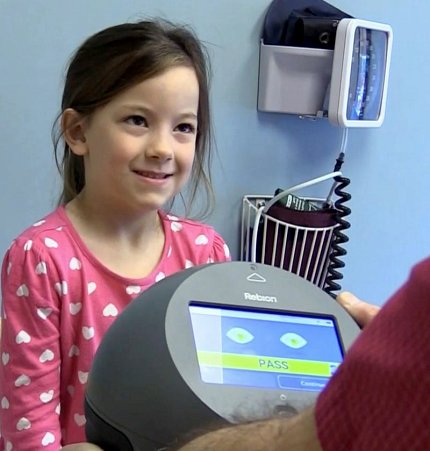Screening Device Accurately Detects Lazy Eye

Photo: Andrew Schuman
A handheld screening device that detects subtle misalignment of the eyes accurately identifies children with amblyopia (lazy eye), according to a study published in the Journal of the American Association for Pediatric Ophthalmology and Strabismus.
Amblyopia, impaired vision in one eye, is the leading cause of preventable monocular (single eye) vision loss, affecting 3 of every 100 children in the U.S. Children with amblyopia can suffer from poor school performance and impaired depth perception and fine motor skills.
Amblyopia develops when misalignment of the eyes (strabismus) or decreased acuity in one eye interferes with the brain’s ability to process visual information from both eyes, causing it to favor one eye. Early detection is crucial. Once a child is visually mature, vision lost in the weaker eye cannot be corrected with glasses or contact lenses.
The screening device works by assessing the eyes’ ability to focus together. Held 14 inches from the eyes, the child fixates on a smiley face while the device simultaneously scans both retinas.
The scan involves a polarized laser that probes nerve fibers in an area of the light-sensing retina called the fovea, an area important for central vision. Even a subtle misalignment of the foveas—called small-angle strabismus—can interfere with the brain’s ability to integrate images from both eyes. The device calculates a binocularity score that indicates whether the child requires further testing.
The study recruited 300 children, ages 2 to 6, with no known eye disorders. Two non-ophthalmic research associates trained to use the device screened each child. A pediatric ophthalmologist who was unaware of the device’s results then examined each child.
The device detected all 6 cases (100 percent sensitivity) of amblyopia and/or strabismus that had been confirmed by the professional eye exam. The device also flagged an additional 45 children as possibly having amblyopia and/or strabismus (85 percent specificity).
Dr. Michael Chiang, director of NEI, which supported research and development of the scanner, said, “The findings suggest that pediatricians and other primary care providers could use the device to catch amblyopia at an early age when it’s easier to treat.”
